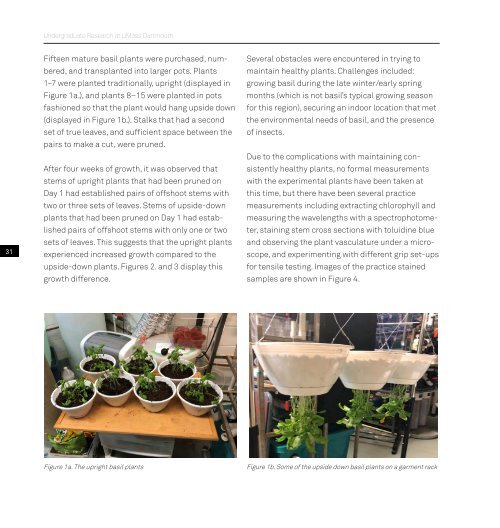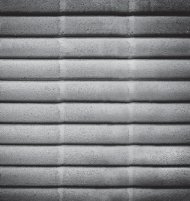Undergrad_Book_16-18_Pge_View_Print_no print marks_compressed
You also want an ePaper? Increase the reach of your titles
YUMPU automatically turns print PDFs into web optimized ePapers that Google loves.
<strong>Undergrad</strong>uate Research at UMass Dartmouth<br />
31<br />
Fifteen mature basil plants were purchased, numbered,<br />
and transplanted into larger pots. Plants<br />
1–7 were planted traditionally, upright (displayed in<br />
Figure 1a.), and plants 8–15 were planted in pots<br />
fashioned so that the plant would hang upside down<br />
(displayed in Figure 1b.). Stalks that had a second<br />
set of true leaves, and sufficient space between the<br />
pairs to make a cut, were pruned.<br />
After four weeks of growth, it was observed that<br />
stems of upright plants that had been pruned on<br />
Day 1 had established pairs of offshoot stems with<br />
two or three sets of leaves. Stems of upside-down<br />
plants that had been pruned on Day 1 had established<br />
pairs of offshoot stems with only one or two<br />
sets of leaves. This suggests that the upright plants<br />
experienced increased growth compared to the<br />
upside-down plants. Figures 2. and 3 display this<br />
growth difference.<br />
Several obstacles were encountered in trying to<br />
maintain healthy plants. Challenges included:<br />
growing basil during the late winter/early spring<br />
months (which is <strong>no</strong>t basil’s typical growing season<br />
for this region), securing an indoor location that met<br />
the environmental needs of basil, and the presence<br />
of insects.<br />
Due to the complications with maintaining consistently<br />
healthy plants, <strong>no</strong> formal measurements<br />
with the experimental plants have been taken at<br />
this time, but there have been several practice<br />
measurements including extracting chlorophyll and<br />
measuring the wavelengths with a spectrophotometer,<br />
staining stem cross sections with toluidine blue<br />
and observing the plant vasculature under a microscope,<br />
and experimenting with different grip set-ups<br />
for tensile testing. Images of the practice stained<br />
samples are shown in Figure 4.<br />
Figure 1a. The upright basil plants<br />
Figure 1b. Some of the upside down basil plants on a garment rack



